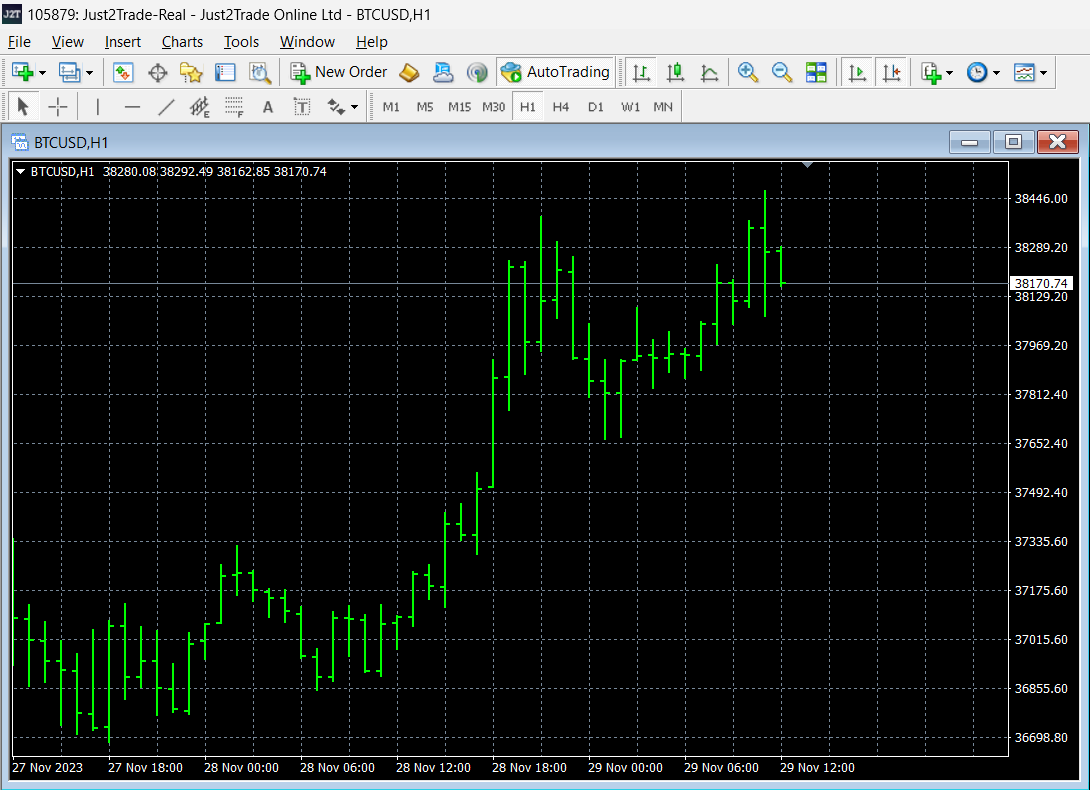How To Trade BTС In Forex?
You need to open an account with a forex broker and download a platform that allows you to trade. Most likely in this case, you will not trade bitcoins directly, but a derivative instrument such as CFDs. The advantage is that you can also allocate your capital to other markets available from the broker. The disadvantage may be the wider spreads compared to those provided by crypto exchanges.
Bitcoin, the pioneering cryptocurrency, has carved a niche in the financial markets as a highly volatile asset. Its price can shift dramatically in a short span, presenting traders with opportunities for substantial profits. However, this volatility is a double-edged sword. It also poses a significant risk of losses.
The interest in bitcoins by traders has led to the fact that gradually all forex brokers have made trading in bitcoins and other cryptocurrencies available using their trading terminals, such as Metatrader, for example.
-
Can I trade bitcoin on my forex funds?
Yes, you can trade Bitcoin with your forex funds, but it's essential to ensure that your broker supports cryptocurrency trading. Also check if the broker allows you to manage positions on weekends. Since the cryptocurrency markets are open 24 hours a day, 7 days a week.
-
Can I trade BTC on mt4?
Yes, you can trade BTC on MetaTrader 4 (MT4) if your selected broker provides the option to trade cryptocurrencies on their platform.
-
Is bitcoin forex safe?
Trading Bitcoin on forex platforms carries risks like any other form of trading, but with a reputable broker and robust risk management strategies, it can be as safe as trading other financial instruments.
-
What is the code for bitcoin forex?
The code for Bitcoin in forex trading platforms is often BTCUSD for the Bitcoin/U.S. Dollar currency pair.
How to trade BTC in Forex
When it comes to Bitcoin trading on Forex, there are two primary avenues: spot trading and derivatives trading. Each offers unique benefits and caters to different trading styles.
-
Spot trading. Spot trading involves purchasing actual Bitcoin and selling them at a higher price. It’s direct and straightforward. To engage in spot trading, one must set up an account with a cryptocurrency exchange that offers liquidity and competitive rates
-
Derivative trading. On the other side of the Bitcoin trading spectrum are derivatives—financial contracts whose value is derived from the performance of an underlying asset, which in this case is Bitcoin
These derivatives include futures, options, and Contracts for Difference (CFDs), each offering a different risk profile and method of exposure to Bitcoin’s price movements.

Source: Metatrader4
For those interested in derivative trading, it is crucial to select a broker that is reputable and transparent.
Best cryptocurrency exchanges
How to trade BTC using technical analysis
Technical analysis is a vital tool for traders navigating the volatile waters of Bitcoin trading. It entails scrutinizing price charts and utilizing various indicators and patterns to forecast future market movements.
Chart patterns
Chart patterns are foundational to technical analysis. They provide a visual representation of market sentiment and potential price movements. Recognizing these patterns can be a game-changer in predicting future price actions. Common patterns include head and shoulders, triangles, flags, and wedges.
Indicators
Indicators serve as the compass for technical analysts, guiding through the market's directional trends and momentum.
There are two primary types of indicators: leading and lagging. Leading indicators, such as the Relative Strength Index (RSI) and Stochastic Oscillator, predict price movements before they occur. Lagging indicators, like moving averages, confirm trends after they have begun.
To harness these tools, traders must select indicators that align with their trading strategy and risk tolerance. It is often recommended to use a combination of both types of indicators to cross-verify signals and improve the accuracy of trade execution.
Support and resistance
Support and resistance levels are the foundation of market psychology, marking key price levels where an asset often experiences pressure.
A support level is where the price tends to find a floor, and buying interest is sufficiently strong to overcome selling pressure. Conversely, resistance levels are where selling pressure overcomes buying interest, creating a ceiling.
To utilize these levels, traders should observe where price reversals have occurred in the past and apply these insights to anticipate future market behavior. Psychological levels, often occurring at round numbers (e.g., $20,000 or $30,000 for Bitcoin), can be particularly strong due to the human propensity to favor round figures. Traders can set entry or exit points near these psychological levels to capitalize on the predictable reactions from the market.
How to trade BTC using fundamental analysis
Unlike technical analysis, fundamental analysis dives into the core factors that can influence Bitcoin's intrinsic value. This approach examines everything from macroeconomic indicators to specific events that could impact supply and demand.
The most important factors to consider when doing BTC fundamental analysis are:
-
Adoption rate. The adoption rate of Bitcoin is a telling sign of its mainstream acceptance and potential for growth. Increasing acceptance by consumers, businesses, and even governments tends to correlate with a rise in Bitcoin's value. Analysts assess adoption through various metrics such as the number of active wallets, transaction volumes, and retail and institutional investment flows. A growing adoption rate can suggest a bullish outlook for Bitcoin
-
Bitcoin halving. Bitcoin halving is a significant event that slashes the reward for mining new blocks in half, occurring approximately every four years. It effectively reduces the rate at which new bitcoins are generated, thereby limiting supply. Historically, halving events have preceded substantial rallies in Bitcoin's price, as the reduced flow of new coins can lead to supply shortages amid steady or increasing demand. Fundamental analysts closely watch the timing of these halvings, as they can be a precursor to a long-term price increase
In addition to these factors, fundamental analysis may include scrutiny of many other factors, such as economic indicators, industry trends, political developments, technological innovations, regulatory updates, network activity etc.
How to trade BTC using on-chain analysis
On-chain analysis offers a deep dive into the blockchain itself, providing a transparent view of Bitcoin's network activity. This form of analysis can yield powerful insights into the movements of large-scale holders, known as whales, and the overall sentiment of the market.
-
Whale movements. A “whale” is a popular name for an entity or individual who holds significant amounts of Bitcoin. Their transactions can have a substantial impact on the market due to the large volume of coins they move. By analyzing the blockchain, traders can track when whales accumulate or reduce their positions. An influx of Bitcoin to exchanges might indicate potential selling pressure, suggesting a bearish sentiment. On the flip side, the withdrawal of Bitcoin from exchanges typically signals accumulation, which could be a bullish sign. Monitoring these movements allows traders to potentially anticipate major price movements
-
Market sentiment. On-chain data can also reflect the broader sentiment of the market. Metrics such as network hash rate, transaction volumes, and active addresses provide a sense of market vitality and trader enthusiasm. For instance, a rising hash rate indicates a strong miner commitment, often correlating with positive sentiment, while a declining hash rate may signal waning confidence
On-chain analysis can give traders a comprehensive view of the Bitcoin market, aligning their strategies with the underlying blockchain dynamics to better navigate the volatile cryptocurrency landscape. Read also about: Generating profits using on-chain metrics and indicators in the TU article.
Risk management
Effective risk management is the cornerstone of sustainable trading, particularly in the volatile realm of Bitcoin. The cryptocurrency's rapid price fluctuations can generate high returns, but they also carry the risk of equally swift losses. Thus, implementing a robust risk management strategy is essential for protecting your capital while pursuing potential profits. You can find some useful tips below:
-
Setting stop loss and take profit levels. One of the fundamental tools in a trader’s arsenal is the use of stop loss and take profit orders. A stop loss order automatically closes a position at a predetermined price level to limit potential losses. Conversely, a take profit order locks in profits by closing a position once it reaches a specific profit target
-
Position sizing. Position sizing is another critical aspect of risk management. It involves determining how much capital to allocate to a single trade, based on the trader’s risk tolerance and overall account size. A common rule of thumb is not to risk more than a small percentage of your capital on any single trade, thus ensuring that no single loss can significantly impact your account balance
-
Diversification. While Bitcoin might be the focus of the trade, diversification across different assets can reduce risk. Diversifying your portfolio with a mix of cryptocurrencies, or even other asset classes, can help spread and mitigate risk, as the performance of these assets can be uncorrelated
-
Risk-reward ratio. Understanding the risk-reward ratio, i.e. how much risk is being taken in comparison to the potential reward is vital. Traders should aim for trades where the potential upside outweighs the downside, ensuring that over time, profits will cover any losses incurred on other trades
-
Continuous education. Lastly, continuous education is a form of risk management. Keeping abreast of market trends, understanding new analysis tools, and learning from past trades are all practices that contribute to more informed decision-making and reduced risk over time
Conclusion
Bitcoin Forex trading has the advantage that the trader can simultaneously manage positions both on the cryptocurrency market and on classical markets - currency, stock and others. However, this does not cancel the need to control risks and conduct a thorough analysis before making trading decisions.
Glossary for novice traders
-
1
Broker
A broker is a legal entity or individual that performs as an intermediary when making trades in the financial markets. Private investors cannot trade without a broker, since only brokers can execute trades on the exchanges.
-
2
Bitcoin
Bitcoin is a decentralized digital cryptocurrency that was created in 2009 by an anonymous individual or group using the pseudonym Satoshi Nakamoto. It operates on a technology called blockchain, which is a distributed ledger that records all transactions across a network of computers.
-
3
Cryptocurrency
Cryptocurrency is a type of digital or virtual currency that relies on cryptography for security. Unlike traditional currencies issued by governments (fiat currencies), cryptocurrencies operate on decentralized networks, typically based on blockchain technology.
-
4
Trading
Trading involves the act of buying and selling financial assets like stocks, currencies, or commodities with the intention of profiting from market price fluctuations. Traders employ various strategies, analysis techniques, and risk management practices to make informed decisions and optimize their chances of success in the financial markets.
-
5
Risk Management
Risk management is a risk management model that involves controlling potential losses while maximizing profits. The main risk management tools are stop loss, take profit, calculation of position volume taking into account leverage and pip value.
Team that worked on the article
Vuk stands at the forefront of financial journalism, blending over six years of crypto investing experience with profound insights gained from navigating two bull/bear cycles. A dedicated content writer, Vuk has contributed to a myriad of publications and projects. His journey from an English language graduate to a sought-after voice in finance reflects his passion for demystifying complex financial concepts, making him a helpful guide for both newcomers and seasoned investors.
Dr. BJ Johnson is a PhD in English Language and an editor with over 15 years of experience. He earned his degree in English Language in the U.S and the UK. In 2020, Dr. Johnson joined the Traders Union team. Since then, he has created over 100 exclusive articles and edited over 300 articles of other authors.
Mirjan Hipolito is a journalist and news editor at Traders Union. She is an expert crypto writer with five years of experience in the financial markets. Her specialties are daily market news, price predictions, and Initial Coin Offerings (ICO).











